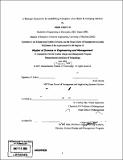A strategic framework for establishing aerospace value chains in emerging markets
Author(s)
Grover, Rishi
DownloadFull printable version (21.51Mb)
Other Contributors
System Design and Management Program.
Advisor
Charley Fine.
Terms of use
Metadata
Show full item recordAbstract
Background: CEO's and top management teams of large corporations in developed countries acknowledge that globalization is the most critical challenge they face today. They are also keenly aware that it has become during the past decade to identify internationalization strategies and to choose which countries to do business with. Still most companies have stuck to the strategies' they have traditionally deployed, which emphasize standardized approaches to new markets with some local twists. As a result they are struggling to come up with successful strategies. Aerospace as a sector has traditionally been much localized to the developed world. This makes leveraging globalization even a bigger challenge.Correlations can be drawn to the field of systems engineering, where specific processes and tools are employed to understand the stakeholder interactions and hence treat Aerospace and emerging markets as a system. EA, System Dynamics, clock speed and Game theory are some of the tools that can analyze such a system accounting for unskilled intermediaries and less skilled legal and contract enforcing systems. Results: The thesis suggests a framework that can help organizations identify the institutional voids existing in Emerging markets and Aerospace sector as a system. An introduction to Aerospace manufacturing and the emerging markets help understand the advantages and disadvantages. The framework is able to do a thorough qualitative assessment of all the potential aspects of building a new value chain Further, it shows that the framework is flexible enough to accommodate the unique aspects of Aerospace as an industry and Emerging countries as a market.Conclusions: Despite the fact that the thesis does not develop a full fledged system dynamics model and do a complete case study, it is still a beneficial framework. It provides a sound process that could be used to design and implement robust value chains. (cont.) It will help organizations understand the institutional differences between countries thus being able to choose the best market to enter, the most optimal strategy and make the most out of operating in Emerging markets. It also leverages each of the system tools such that they deliver most value by providing the best suited magnification lens.
Description
Thesis (S.M.)--Massachusetts Institute of Technology, System Design and Management Program, February 2008. Includes bibliographical references (leaves 116-117).
Date issued
2008Department
System Design and Management Program.Publisher
Massachusetts Institute of Technology
Keywords
System Design and Management Program.